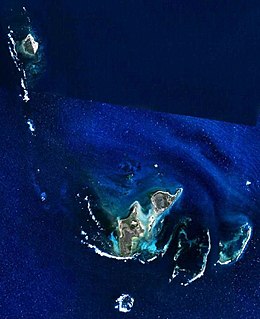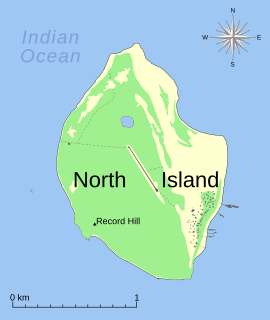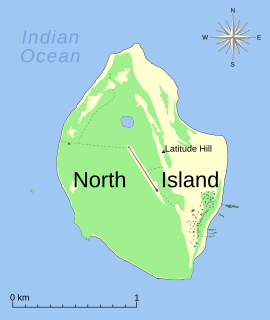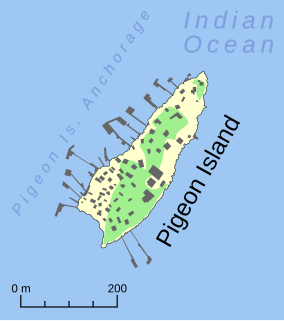Related Research Articles

The Houtman Abrolhos is a chain of 122 islands, and associated coral reefs, in the Indian Ocean off the west coast of Australia, about eighty kilometres (50 mi) west of Geraldton, Western Australia. It is the southernmost true coral reef in the Indian Ocean, and one of the highest latitude reef systems in the world. It is one of the world's most important seabird breeding sites, and is the centre of Western Australia's largest single-species fishery, the western rock lobster fishery. It has a small seasonal population of fishermen, and a limited number of tourists are permitted for day trips, but most of the land area is off limits as conservation habitat. It is well known as the site of numerous shipwrecks, the most famous being the Dutch ships Batavia, which was wrecked in 1629, and Zeewijk, wrecked in 1727.

The Wallabi Group is the northernmost group of islands in the Houtman Abrolhos off the western coast of Western Australia. it is 58 kilometres from the Australian mainland, and about 9 kilometres from the Easter Group.

The Pelsaert Group is the southernmost of the three groups of islands that make up the Houtman Abrolhos island chain. it consists of a number of islands, the largest of which are Gun Island, Middle Island, and Pelsaert Island. The group is named after a Dutch "opperkoopman" who stranded nearby with the VOC-ship "Batavia" in 1629. The group contains the most southerly true coral reefs in the Indian Ocean. The group is part of the Houtman Abrolhos Important Bird Area, identified as such by BirdLife International because of its importance for supporting large numbers of breeding seabirds.

North Island is the northernmost island in the Houtman Abrolhos, a coral reef archipelago in the Indian Ocean off the coast of Mid West Western Australia. Located about 14 km (9 mi) from the nearest island group, it is one of the largest islands in the Houtman Abrolhos, and one of the few to support dune systems. It has relatively diverse flora dominated by chenopod shrubs and fauna that includes the introduced tammar wallaby, around seven species of reptile, and about 15 resident bird species.
Suda Bay was a 14.3 ton motor boat that was one of the first boats used for a commercial tourist operation in the Houtman Abrolhos.

Batavia Road was a passenger boat used from 1946 for commercial tourist operation in the Houtman Abrolhos, a group of islands off the coast of Western Australia.

Record Hill is the highest hill on North Island in the Houtman Abrolhos. It is located in the southwest of the island; its gazetted location is 28°18′19″S113°35′29″E, but in fact it is located about 150 metres north of there at 28°18′15″S113°35′29″E. It is about 13 metres (42 ft) high.
Barker Passage is a channel through reef about a kilometre south of North Island in the Houtman Abrolhos. Its gazetted location is 28°19′15″S113°37′15″E, but it is actually located nearly 2½ kilometres west of there, at approximately 28°18′58″S113°35′54″E.

Latitude Hill is a hill on North Island in the Houtman Abrolhos. It is located in the east of the island, at 28°18′4″S113°35′59″E.
The Flat is an anchorage just north of North Island in the Houtman Abrolhos. It is located at 28°16′44″S113°35′3″E.

South Passage is a 14 kilometre (9 mi) wide strait that separates the outlying North Island from other islands in the Wallabi Group of the Houtman Abrolhos island chain, in the Indian Ocean off the coast of Western Australia. It is nominally located at 28°21′14″S113°35′46″E.

North East Reef is a reef in the Wallabi Group of the Houtman Abrolhos, in the Indian Ocean off the coast of Western Australia. Located at 28°25′13″S113°48′41″E, it takes its name from the fact that it is situated to the north-east of the main body of islands that makes up the Wallabi Group. The island is part of the Houtman Abrolhos Important Bird Area, identified as such by BirdLife International because of its importance for supporting large numbers of breeding seabirds.

Fish Point is a point in the north-eastern corner of East Wallabi Island in the Houtman Abrolhos island chain off the coast of Western Australia. It is located at 28°25′40″S113°44′34″E. It sits at the foot of Flag Hill, the highest peak on East Wallabi Island, and its western edge looks out onto Turtle Bay.

Gun Island is one of the larger islands in the Pelsaert Group of the Houtman Abrolhos, in the Indian Ocean off the west coast of Australia. It is nominally at 28°53′10″S113°51′35″E, about 4 km (2.5 mi) north and east of Half Moon Reef and is a flat limestone outcrop of about 800 by 420 metres in size. The island is part of the Houtman Abrolhos Important Bird Area, identified as such by BirdLife International because of its importance for supporting large numbers of breeding seabirds.

Pigeon Island is a small island located need the middle of the Wallabi Group of the Houtman Abrolhos, an archipelago off the coast of Western Australia. It is almost entirely given over to western rock lobster fishers' camps, and as a result is far more disturbed than most other islands in the archipelago. A nearby island also seasonally populated by fishers is named Little Pigeon Island, hence Pigeon Island is sometimes referred to as "Big Pigeon Island".
Shag Rock is a small rocky island in the Wallabi Group of the Houtman Abrolhos.

East Wallabi Island is an island in the Wallabi Group of the Houtman Abrolhos, located in the Indian Ocean off the west coast of mainland Australia.
West Wallabi Island is an island in the Wallabi Group of the Houtman Abrolhos, in the Indian Ocean off the west coast of mainland Australia.

Geelvink Channel is a feature to the east of the Houtman Abrolhos in the Indian Ocean off the coast of Western Australia, that lies between the Abrolhos and the port of Geraldton.

Pelsaert Island is one of the islands of the Pelsaert Group, which is the southernmost of the three groups of islands that make up the Houtman Abrolhos island chain in Western Australia.
References
- ↑ Gazetteer of Australia (1996). Belconnen, ACT: Australian Surveying and Land Information Group.
- ↑ "Suda Bay Passage". Gazetteer of Australia online. Geoscience Australia, Australian Government. "Place names search, Geoscience Australia". Archived from the original on 28 March 2012. Retrieved 13 March 2017.
{{cite web}}: CS1 maint: bot: original URL status unknown (link) - ↑ "Sustainable Tourism Plan for the Abrolhos Islands" (PDF). Fisheries Management Paper. Perth, Western Australia: Fisheries Western Australia. 2001. Archived from the original (PDF) on 24 March 2012. Retrieved 17 November 2007.